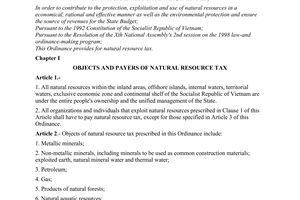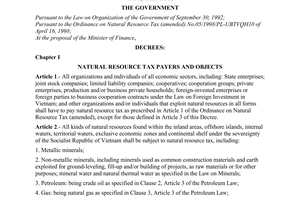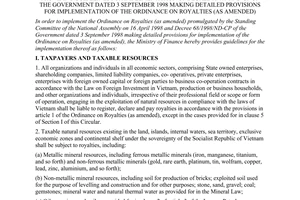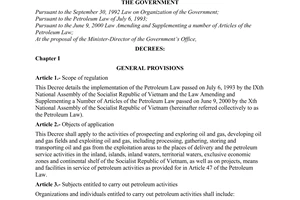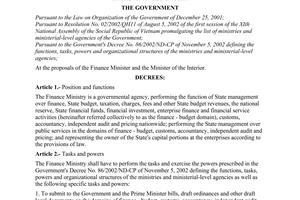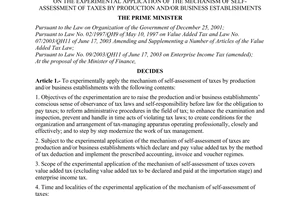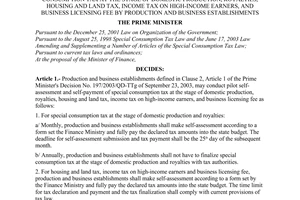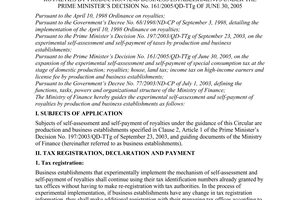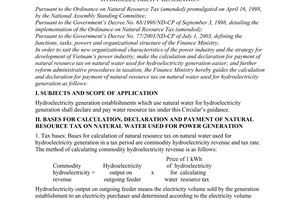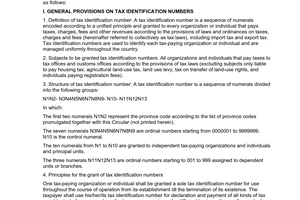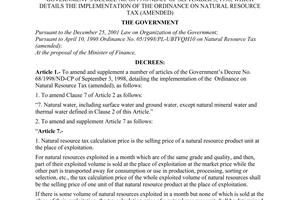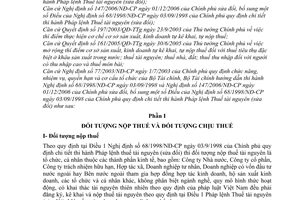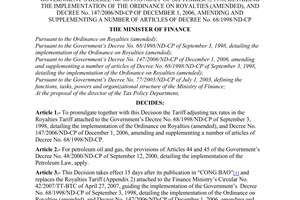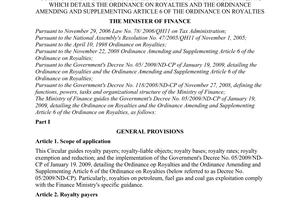Circular No. 42/2007/TT-BTC of April 27, 2007 guiding the implementation of The Governments Decree No. 68/1998/ND-CP of September 3, 1998, detailing the implementation of the ordinance on royalties (amended and Decree No. 147/2006/ND-CP of December 1, 2006, amending and supplementing a number of articles of Decree No. 68/1998/ND-CP đã được thay thế bởi Circular No. 124/2009/TT-BTC of June 17, 2009, guiding the Government's Decree No. 05/2009/ND-CP of January 19,2009, which details the Ordinance on royalties and the ordinance amending and supplementing Article 6 of the Ordinance on royalties và được áp dụng kể từ ngày 01/08/2009.
Nội dung toàn văn Circular No. 42/2007/TT-BTC of April 27, 2007 guiding the implementation of The Governments Decree No. 68/1998/ND-CP of September 3, 1998, detailing the implementation of the ordinance on royalties (amended and Decree No. 147/2006/ND-CP of December 1, 2006, amending and supplementing a number of articles of Decree No. 68/1998/ND-CP
|
THE MINISTRY OF
FINANCE |
SOCIALIST REPUBLIC OF VIET NAM |
|
No: 42/2007/TT-BTC |
Hanoi, April 27, 2007 |
CIRCULAR
GUIDING THE IMPLEMENTATION OF THE GOVERNMENT’S DECREE NO. 68/1998/ND-CP OF SEPTEMBER 3, 1998, DETAILING THE IMPLEMENTATION OF THE ORDINANCE ON ROYALTIES (AMENDED) AND DECREE NO. 147/2006/ND-CP OF DECEMBER 1, 2006, AMENDING AND SUPPLEMENTING A NUMBER OF ARTICLES OF DECREE NO. 68/1998/ND-CP
Pursuant to the Ordinance on Royalties
(amended) promulgated by the National Assembly Standing Committee on April 16,
1998;
Pursuant to the Government’s Decree No. 68/1998/ND-CP of September 3, 1998,
detailing the implementation of the Ordinance on Royalties (amended);
Pursuant to the Government’s Decree No. 147/2006/ND-CP of December 1, 2006,
amending and supplementing a number of articles of the Government’s Decree No.
68/1998/ND-CP of September 3, 1998, detailing the implementation of the
Ordinance on Royalties (amended);
Pursuant to the Prime Minister’s Decision No. 197/2003/QD-TTg of September 23,
2003, on the trial implementation of the mechanism of tax self-assessment and
self-payment by production and business establishments;
Pursuant to the Prime Minister’s Prime Minister’s Decision No. 161/2005/QD-TTg
of June 30, 2005, on expansion of the trial implementation of the mechanism of
production and business establishments’ self-assessment and self-payment of
special consumption tax at the domestic production stage; royalties; house and
land tax; income tax on high income earners and license tax;
Pursuant to the Government’s Decree No. 77/2003/ND-CP of July 1, 2003, defining
the functions, tasks, powers and organizational structure of the Ministry of
Finance,
The Ministry of Finance guides the implementation of the Government’s Decree
No. 68/1998/ND-CP of September 3, 1998, and Decree No. 147/2006/ND-CP of
December 1, 2006, amending and supplementing a number of articles of the
Government’s Decree No. 68/1998/ND-CP of September 3, 1998, detailing the
implementation of the Ordinance on Royalties (amended) as follows:
Part I
TAXPAYERS AND TAXABLE OBJECTS
I. TAXPAYERS
Under Article 1 of the Government’s Decree No. 68/1998/ND-CP of September 3, 1998, detailing the implementation of the Ordinance on Royalties (amended), organizations and individuals of all economic sectors, including state companies, joint-stock companies, limited liability companies, cooperatives, private enterprises, with foreign-invested enterprises and foreign parties to business cooperation contracts, business and production households and other organizations and individuals, irrespective of business lines and trades, scope and form of operation, which exploit natural resources under the provisions of Vietnamese law shall make registration, declaration and payment of royalties according to Article 1 of the Ordinance on Royalties (amended). Some cases are specified as follows:
1. Foreign-invested enterprises and foreign parties to business cooperation contracts that are paying natural resources levies or royalties at the specific levels stipulated in their investment licenses issued before June 1, 1998, continue to pay such levies or royalties till the expiration of the issued licenses. If their investment licenses are extended after the effective date of this Circular, they shall comply with the guidance in this Circular.
2. According to Article 3 of the Ordinance on Royalties (amended) and Article 3 of the Government’s Decree No. 68/1998/ND-CP of September 3, 1998, when the Vietnamese party to a joint venture with a foreign party operating under of the Law on Foreign Investment in Vietnam (now the Investment Law) contributes its share of legal capital in the form of natural resources as specified in the investment license, the joint venture enterprise is not required to pay royalties on the natural resources which the Vietnamese party contributes to the legal capital. Every three months and six months, the Vietnamese party shall make declarations of natural resources already contributed as capital and report them to the Ministry of Finance for recording as state budget capital and for management in accordance with current regulations.
3. For enterprises established between Vietnamese party and foreign party in the form of joint venture, business cooperation contract or product-sharing contract, the royalties to be paid by the joint venture enterprise or by the foreign party shall be stated in the joint venture contract, business cooperation contract or product-sharing contract and, if so agreed, included in the portion of products distributed to the Vietnamese party. When products are shared, the Vietnamese party shall pay the royalties on the whole exploited quantity of natural resources into the state budget in accordance with the Budget Law.
4. When natural resources banned from exploitation are seized, confiscated and permitted for sale, the selling organizations shall fully include the royalties in the sale prices and remit the proceeds into the budget.
II. TAXABLE OBJECTS
Under Article 2 of the Government’s Decree No. 68/1998/ND-CP of September 3, 1998, detailing the implementation of the Ordinance on Royalties (amended), subject to royalties are natural resources located within the scope of the land, islands, internal waters, territorial waters, exclusive economic zone (including overlapping sea areas between Vietnam and related states) and the continental shelf under the sovereignty of the Socialist Republic of Vietnam, which include:
1. Metal minerals, including ferrous metal (iron, manganese, titanium, etc.) and non-ferrous metal (gold, rare earth, platinum, tin, wolfram, copper, lead, zinc, aluminum, etc.).
2. Non-metal minerals, including earth for making bricks, earth exploited for ground leveling and filling or for the construction of works, and earth exploited for other purposes; stone, sand, gravel, coal, gems, etc., natural mineral water and hot water falling in the category stipulated in the Law on Minerals;
3. Oil, meaning crude oil defined at Clause 2, Article 3 of the Law on Petroleum;
4. Gas, meaning natural gas defined in Clause 3, Article 3 of the Law on Petroleum;
5. Products of natural forests, including plant and animal species permitted for exploitation which are products of natural forests, such as timber (including tree branches, tops, firewood, stumps and roots, etc., defined according to the standards set by the Ministry of Agriculture and Rural Development), bamboo of various kinds; pharmaceutical materials of various kinds, etc., and plant and animal species permitted for exploitation;
6. Natural aquatic resources, including natural animal and plant species in the sea, rivers, natural arroyos, lakes, ponds, lagoons, etc.
7. Natural water, including:
7.1. Surface water: sea, lakes, rivers, springs, canals, ditches, ponds, dams, etc.;
7.2. Groundwater (except for thermal natural water and mineral water mentioned at Point 2 of this Section).
8. Other natural resources not falling in the groups mentioned above.
Part II
TAX BASES AND ROYALTIES TARIFF
The bases for calculation of royalties are the quantity of commercial natural resources actually exploited in a period, the taxable price of one unit of natural resource and the royalties rate.
The royalties to be paid in the tax period shall be calculated as follows:
|
Royalties to be paid in the period |
= |
Quantity of commercial natural resources exploited in the period |
x |
Taxable price of one unit of natural resource |
x |
Royalties rate |
- |
Royalties amount of reduced or exempted(if any) |
For natural resources subject to royalties rates based on one unit of exploited natural resource, the payable royalties shall be determined as follows:
Royalties to be paid in the period = Quantity of commercial natural resources exploited in the period x Royalties rate based on one unit of natural resource.
I. QUANTITY OF COMMERCIAL NATURAL RESOURCES ACTUALLY EXPLOITED
Under Article 6 of the Government’s Decree No. 68/1998/ND-CP of September 3, 1998, detailing the implementation of the Ordinance on Royalties (amended), the quantity used for calculation of royalties shall be determined in each case as follows:
1. For the type of natural resource which can be determined in terms of quantity, weight or volume, the taxable quantity of commercial natural resources is the quantity, weight or volume of natural resources actually exploited during the tax period, irrespective of the present conditions and the purposes of exploiting natural resources (for immediate sale, exchange, internal use or as provisions for subsequent production, etc.).
2. For the type of natural resource which cannot be determined in terms of quantity, weight or volume actually exploited as it contains different substances and great contents of extraneous matters, the taxable quantity of natural resource shall be calculated on the basis of the quantity, weight or volume of each substance collected as a result of sorting and classification.
Example: One company in a tax period must screen and sort out thousands of cubic meters of earth, rock and water (the quantity of which cannot be determined) in order to obtain 2 kg of gold nuggets, 100 tons of iron ore, etc., the royalties shall be calculated on the basis of the quantities of gold nuggets and iron ore. At the same time, the quantities of other types of natural resources exploited and used for exploitation activities, such as water exploited and used for screening and sorting activities, shall be determined.
3. For the type of natural resource exploited and immediately used for the production of products or provision of other services, its taxable quantity shall be calculated on the basis of the output of products produced in the period and the natural resource waste norm per product unit.
Example: In order to produce 1,000 bricks (unbaked), 1 m3 clay is needed. If in the month, the clay-exploiting establishment produces 100,000 bricks, the quantity of exploited clay subject to royalties is 100,000 bricks (:) 1,000 bricks = 100 m3.
4. For natural water used for hydropower generation: It is the electricity volume sold by the generation establishment to an electricity buyer and determined through the electricity counting system meeting Vietnam measurement standards and located at the delivery and receipt point. This electricity volume is certified by the electricity buyer and seller.
5. In case of exploitation carried out manually, in a scattered manner or on a mobile or irregular basis, with the annually exploited quantity of natural resources estimated at under VND 200,000,000, which is difficult to manage, a presumptive quantity of natural resource can be set on a seasonal or periodical basis. Tax offices shall coordinate with local administrations and specialized management bodies to fix the presumptive exploited quantity of natural resource.
Also in the same case, if the exploited natural resources are collected and bought by a single buyer only and if accepted in writing by the buyer, the municipal/provincial Tax Department may decide (in writing) to let the buyer pay royalties on behalf of the exploiter.
II. TAXABLE PRICES
Under Article 7 of the Government’s Decree No. 68/1998/ND-CP of September 3, 1998, detailing the implementation of the Ordinance on Royalties (amended) and Clause 2, Article 1, of the Government’s Decree No. 147/2006/ND-CP of December 1, 2006, amending and supplementing a number of articles of the Government’s Decree No. 68/1998/ND-CP the price for calculating royalties is the sale price of one unit of natural resources at the place of exploitation in compliance with the market price principle and shall be determined in each specific case as follows:
1. For natural resources the quantity of which may be determined at the exploitation stage and which may be sold immediately after the exploitation (such as earth, stone, sand, gravel, aquatic products, etc.), the taxable price of one unit of natural resource is the actual sale price exclusive of VAT.
2. For exploited natural resources of the same quality grade part of which is sold at the place of exploitation at the market price and part of which is transported away for sale or production, processing, screening, sorting, etc., the taxable price of one unit of the whole quantity of natural resource exploited in the month is the sale price of one unit of natural resource at the place of exploitation, which is obtained by dividing total turnover (exclusive of valued added tax) from natural resources sold at the place of exploitation by total quantity of these natural resources sold in the month.
When some quantity of natural resource is exploited in the month but no turnover is generated from the sale thereof at the place of exploitation, the taxable price of one unit of natural resource used for calculating the royalties amount of the month is that of the previous month or the accounting price. At the end of the business period, the actual sale price of the quantity of exploited natural resources already declared for taxation purposes shall be used for determining the payable royalties amount in the royalties finalization declaration.
3. If the sale price of one unit of exploited natural resource at the exploitation place mentioned at Point 1.2 of this Section cannot be determined, the taxable price shall be determined in some specific cases as follows:
3.1. For the type of natural resource the quantity of which may be determined at the exploitation stage but which must go through screening, sorting and selection, etc., before it can be sold out, the taxable price of one unit of natural resource is that of the products which have gone through screening, sorting and classification less (-) expenses incurred at the screening, sorting and selection stage and converted by content or proportion so as to determine the taxable price as the actual sale price of the exploited natural resource exclusive of value added tax.
Example: The sale price of clean coal is VND 65,000/ton (exclusive of VAT), the cost of screening, sorting and transportation from the place of exploitation to the place of sale is VND 10,000/ton and the proportion of clean coal in actually exploited coal is 80%, then:
|
Price for calculating royalties on one ton of coal at the place of exploitation |
= |
(VND 65,000 - VND 10,000) |
x |
80 |
|
100 |
3.2. For the type of natural resource the quantity of which cannot be determined at the exploitation stage as it contains numerous extraneous substances, the taxable price of one unit of the natural resource is the sale price (exclusive of valued added tax) of one unit of pure products of the substance with the highest content in the exploited natural resource or the sale price of pure products of each substance in the exploited natural resource (if these substances can be separated after exploitation, for example, gold nuggets, iron ore, etc.
4. For timber, the taxable price of one unit of natural resource is the sale price at the delivery site.
5. The price for calculating royalties on natural water used in hydropower generation, which is set at VND 750 per kWh of commercial electricity, is applicable from January 1, 2007. Hydropower generation establishments which have declared and paid royalties on water used in hydropower generation for 2007 at the taxable price of VND 700 per kWh shall adjust the taxable price under the guidance of this Circular when making royalties finalization declarations for 2007.
When the average retail price of electricity is adjusted, the price for calculating royalties per kWh of hydroelectricity is the pre-adjustment price for calculating royalties per kWh of hydroelectricity multiplied by the adjustment co-efficient.
The adjustment co-efficient shall be determined according to the following formula:
|
Adjustment co-efficient |
= |
Average retail price of 1 kWh of electricity at the time of adjustment |
|
Average retail price of 1 kWh of electricity before the time of adjustment |
6. For organizations and individuals exploiting natural resources not for sale but for use as raw materials for the production of other products or the provision of other services; organizations and individuals exploiting natural resources and paying royalties according to declarations but failing to fully comply with the prescribed system of accounting books and documents; and for organizations and individuals paying royalties by the assessment method, they shall apply the taxable price of one unit of natural resource which is stipulated by provincial-level People’s Committees for each period.
Provincial-level Tax Departments shall assume the prime responsibility for, and coordinate with provincial-level Finance-Pricing Services and Natural Resources and Environment Services in investigating the market prices of natural resources in their localities, making price adjustment plans and submitting them to provincial-level People’s Committees for decision and reporting to the Ministry of Finance (the General Department of Taxation). When the sale price of a natural resource sees big fluctuations (up or down by 20%), the price for calculating royalties on the natural resource shall be adjusted accordingly.
Tax offices directly managing the collection of royalties shall publicize the taxable price of one unit of each natural resource at their head offices.
7. Particularly for oil and gas, the price for calculating royalties is in accordance with the provisions of the Law on Petroleum and Article 46 of the Government’s Decree No. 48/2000/ND-CP of September 12, 2000, detailing the implementation of the Law on Petroleum.
III. ROYALTIES TARIFF
Under Article 8 of the Government’s Decree No. 68/1998/ND-CP of September 3, 1998, detailing the implementation of the Ordinance on Royalties (amended), the royalties rate for each type of natural resource exploited complies with the Royalties Tariff promulgated together with Decree No. 68/1998/ND-CP For some types of natural resources, the royalties rates are specified below:
1. Natural water exploited for the production of ice (excluding production of purified ice): 1%.
2. Apatite ore and serpentine exploited for sale: 2%.
3. Section VII of the Royalties Tariff promulgated together with Decree No. 68/1998/ND-CP of September 3, 1998, detailing the implementation of the Ordinance on Royalties (amended) is guided as follows: “VII. Mineral water, natural water” is as stipulated in Clause 4, Article 1, of the Government’s Decree No. 147/2006/ND-CP if December 1, 2006.
4. For petroleum and gas, their royalties rates are defined in Article 44 and Article 45 of the Government’s Decree No. 48/2000/ND-CP of September 12, 2000, detailing the implementation of the Petroleum Law.
On the basis of the above royalties rates, the royalties rates are specified in the Royalties Tariff (Appendix 2) promulgated together with this Circular.
Part III
DECLARATION, REGISTRATION, PAYMENT AND FINALIZATION OF ROYALTIES
I. REGISTRATION OF ROYALTIES
1. Newly founded business establishments engaged in exploiting natural resources shall register for the grant of tax identification numbers and the payment of royalties under the Ministry of Finance’s Circular No. 10/2006/TT-BTC of February 14, 2006, guiding the implementation of the Prime Minister’s Decision No. 75/1998/QD-TTg of April 4, 1998, stipulating tax identification numbers of taxpayers who pay tax at their managing tax offices and at tax offices of the places of exploitation of natural resources. In the course of implementation, if changing any content of the royalties registration, business establishments shall make additional declaration to their managing tax offices according to current regulations on tax registration.
2. Existing business establishments adding exploitation of natural resources as a new business line may continue using the tax identification numbers already granted by tax offices for making additional registration of the exploitation of natural resources with the tax offices of the localities where they are headquartered and the tax offices that directly manage their natural resources-exploiting units according to current regulations on tax registration.
II. DECLARATION OF ROYALTIES
Organizations and individuals exploiting natural resources shall submit royalties declaration dossiers to tax offices directly managing the collection of royalties.
1. For organizations and individuals paying royalties by the assessment method:
For organizations and individuals exploiting natural resources manually on a scattered basis with an annually exploited value of under VND 200,000,000 and paying royalties by the assessment method as guided by the tax offices, the declaration of royalties, the assessment of payable royalties amounts, and the determination of the period of payment of stable assessed royalties amounts shall be conducted at the same time with the assessment of valued added tax and enterprise income tax according to current regulations. The assessed royalties amount payable on a monthly basis shall be based on the quantity of exploited natural resources and the turnover used as a basis for assessing valued added tax.
Tax offices shall accurately determine the quantities of natural resources actually exploited and the payable royalties amounts on the basis of the declarations of natural resources-exploiting establishments and documents on field investigations of natural resources, capital, labor, exploitation methods and prices of natural resources. The assessment of payable royalties amounts must be public, democratic and close to the natural resources exploitation capacity.
In the period of payment of stable assessed royalties amounts, if the arising quantity of natural resources actually exploited and the price for calculating royalties thereon are higher than figures used for the declaration and assessment of royalties, organizations and individuals shall declare them to the tax office for adjustment of the payable royalties amount in the subsequent period. If they fail to do so and are detected through inspections, they shall be forced to pay the arising royalties amount and be administratively sanctioned for late royalties registration but not for tax evasion.
Before exploiting natural resources, organizations and individuals paying royalties by the assessment method shall declare the payment of royalties on exploited natural resources at the same time with registering royalties with the tax offices directly managing the collection of royalties according to current regulations. At the end of a business period, they are not required to make royalties finalization declarations, including those that are entitled to royalties exemption or reduction on a case-by-case basis under the guidance in Part IV of this Circular.
2. For organizations and individuals paying royalties by the declaration method:
2.1. Monthly declaration of royalties:
a/ Monthly, business establishments shall make full calculation and declaration of royalties according to current regulations in form No. 01/TNg attached to this Circular. If no royalties is incurred in the month, business establishments shall still fill in and send the declarations to tax offices.
- Business establishments shall fill in all items in the declaration form (tax identification number, name, address, location of natural resource exploitation, etc.) and declare other relevant information such as having made tax registration with the tax office, and concurrently certify the legal validity of the declared information (by affixing their signature and seal). Declarations shall be regarded as not having been submitted to the tax office if they are not fully filled in or not duly certified.
- The deadline for submission of monthly royalties declarations to tax offices is the 20th of the subsequent month. Business establishments shall submit their declarations by post or directly to the tax office. The date of submission shall be determined as the date of the postmark affixed by the sending post office (for declarations submitted by post) or the date of submission to the tax office (for declarations submitted directly to the tax office).
b/ For types of natural resources for which the bases for calculation of royalties arising in the month have not yet been identified and declared, business establishments may estimate the royalties amount to be paid every month for these types of natural resources on the basis of accounting prices. Accordingly, for making monthly royalties declarations, business establishments shall determine royalties to be paid in the month on the basis of the accounting price of one unit of natural resource sold. At year-end, they shall re-determine the payable royalties amount based on the actual taxable sale price of one unit of natural resource and make royalties finalization declarations.
c/ Declaration of estimated rebatable royalties amounts: Business establishments which properly apply cost-accounting, pay royalties by the declaration method and are eligible for royalties rebate shall estimate rebatable royalties amounts every month under the guidance in Part IV of this Circular and declare them in monthly declarations.
2.2. Royalties finalization declaration:
a/ Business establishments that apply self-assessment and self-payment of royalties at the end of the business period shall make royalties finalization declarations according to form No. 02/TNg attached to this Circular, Annual royalties finalization declarations shall be made and submitted to the tax office for determining royalties amounts actually arising in the year.
The time limit for submission of royalties finalization declarations is 90 days from the end of the calendar year or fiscal year. In case of termination of natural resources exploitation contracts; merger, consolidation, division, separation, dissolution, bankruptcy, transformation of ownership; assignment, sale, contracting and lease of state enterprises, business establishments shall make royalties finalization declarations and send them to the tax office within 45 days from the date of termination of natural resources exploitation contracts or from the date of issuance of the merger, consolidation, division, separation, solution, bankruptcy, transformation of ownership, assignment, sale, contracting or lease decision by competent authorities.
b/ For a hydropower generation establishment which is headquartered in a locality and has its payable royalties amount divided to other localities according to regulations of the Ministry of Finance, the tax office in charge of royalties of the locality where the establishment’s hydropower plant is located shall send copies of the royalties declaration and the royalties finalization declaration to related tax offices entitled to collect royalties for information.
c/ Determination of rebatable royalties amounts: Business establishments eligible for royalties rebate shall determine by themselves rebatable royalties amounts on the basis of actual figures, and concurrently compile dossiers stating the bases for royalties rebate and send them to the tax office according to regulations.
Monthly, business establishments exploiting natural resources shall assess by themselves their satisfaction of the royalties rebate conditions, estimate the rebatable royalties amounts and declare them in royalties declarations No. 01/TNg. At the end of the year of natural resources exploitation, on the basis of actual figures on natural resources exploited in the year, business establishments shall determine by themselves the rebatable royalties amounts, declare them in annual royalties finalization declarations and send them together with the set of documents on the rebatable natural resources amounts to their managing tax offices for monitoring and supervision.
2.3. Attached to this Circular are the royalties declaration form (No. 01/TNg), the royalties finalization declaration form (No. 02/TNg) and the instruction on royalties declaration (Appendix 1).
2.4. Business establishments are accountable before law for the truthfulness and accuracy of their royalties declaration and fully preserve documents used for determination of royalties amounts already declared.
III. ROYALTIES PAYMENT
1. Organizations and individuals paying royalties by the assessment method: Monthly, they shall pay royalties amounts as assessed on the last day of the month at the latest.
2. Organizations and individuals paying royalties by the declaration method:
2.1. Monthly, business establishments shall pay their declared royalties amounts into the state budget. The deadline for monthly payment of royalties is the 20th of the subsequent month. If there are any outstanding royalties amounts according to their royalties finalization declarations, business establishments shall pay them into the state budget within 90 days from the end of the calendar year or fiscal year.
2.2. In case of termination of natural resource exploitation contracts; merger, consolidation, division, separation, dissolution, bankruptcy, transformation of ownership; assignment, sale, contracting or lease of state enterprises, business establishments shall fully pay outstanding royalties amounts within 45 days from the date of termination of natural resource exploitation contracts or from the date of issuance of the merger, consolidation, division, separation, dissolution, bankruptcy, transformation of ownership, assignment, sale, contracting or lease decision by competent authorities; if there are any overpaid royalties amounts, the tax office shall refund them or transfer them to the new business establishments according to current regulations.
2.3. For business establishments paying royalties into the state budget by transfer via a bank or another credit institution, the date of tax payment shall be determined as the date on which the bank or credit institution deducts and transfers the tax money to the treasury as requested in the business establishments’ orders of payment into the state budget; for business establishments paying royalties in cash, the date of payment shall be determined as the date on which the state treasury or tax office receives the tax money stated on the money payment documents.
2.4. Business establishments shall fully fill in the money payment documents as guided by the tax office or state treasury. They shall clearly write on the money payment documents the royalties amounts paid for each type of tax and fines for each period; particularly for fines paid for late payment of tax money or fines, they shall write the date of the tax office’s notice but not the fine paid for late payment of each type of tax. When a business establishment has both the tax amount and fine paid in the period and the tax amount and fine owed from previous periods, which are unspecified, the tax office shall first deduct the owed tax amount and fine, then the royalties amount and fine paid in the period.
2.5. For a business establishment paying royalties on water used for hydropower generation to different localities, the state treasury of the place where the hydropower generation unit pays royalties shall divide the royalties amount paid by the unit in proportion (%) to beneficiary localities under decision of the Ministry of Finance.
Part IV
ROYALTIES EXEMPTION AND REDUCTION
Royalties exemption and reduction under Article 10 of the Ordinance on Royalties (amended), Article 12 of the Government’s Decree No. 68/1998/ND-CP of September 3, 1998, detailing the on implementation of the Ordinance on Royalties (amended), Clause 3, Article 1 of the Government’s Decree No. 147/2006/ND-CP of December 1, 2006, amending and supplementing Decree No. 68/1998/ND-CP and the provisions of the Investment Law shall be effected as follows:
I. Organizations and individuals exploiting natural resources and paying royalties by declaration which meet with natural disaster, sabotage or unexpected accident, causing damage to the quantities of natural resources they have declared and paid royalties for, are entitled to exemption from the royalties to be paid for the damaged natural resources. The paid royalties amount, if any, shall be refunded or deducted from the royalties amount to be paid in the subsequent period.
The exemption from royalties stated at this Point is only applicable to damaged natural resources which have not yet been processed into other products and which still maintain their original physic and chemical characteristics.
1. The level of damage of natural resources shall be determined as follows:
- For the type of natural resource suffering from damage in terms of quantity, the damage shall be determined on the basis of the actual damaged quantity;
- For the type of natural resources suffering from damage in terms of quality grade and proportion, assessment shall be conducted to re-determine the taxable prices and payable royalties amounts. The to-be-exempted royalties amount is the difference between the previously calculated and declared royalties amount and the payable royalties amount calculated after the damage is caused.
Example: The proportion of clean coal in the exploited coal is 80%. During the rainy period, this proportion drops to 50%. Therefore, the taxable price must be re-calculated to determine the to-be-exempted royalties amount.
2. Procedures for application of royalties exemption comprise:
- A written request clearly indicating the reason, the natural resource damage, the royalties amount re-determined on the basis of the damage, and the proposed to-be-exempted royalties amount (with certification of the People’s Committee of the commune, ward or township where natural resources are damaged;
- A minute of inspection and certification by the managing tax office, enclosed with the dossier of request for royalties exemption.
II. Those organizations and individuals conducting offshore exploitation of aquatic resources by great-capacity vehicles are entitled to exemption from royalties for the first five years counting from the date of issue of exploitation licenses and to a 50% reduction of royalties for subsequent five years.
Great-capacity vehicles are aquatic resources-exploiting ships and vessels fitted with main motors of 90 horse power (CV) upwards.
Based on their licenses for offshore exploitation of aquatic resources, organizations and individuals shall assess by themselves their satisfaction of royalties exemption and reduction conditions and notify their managing tax offices of the period in which they are entitled to royalties exemption and reduction.
For business establishments conducting offshore exploitation of aquatic resources and paying royalties by the declaration method, at the end of the tax period, they shall determine by themselves the actually exempted or reduced royalties amounts in order to make royalties declarations and take responsibility for the exempted or reduced royalties amounts they declare. Those that dishonestly assess their conditions for royalties exemption or reduction in order to enjoy the exempted or reduced royalties amounts higher than they are entitled to shall be forced to pay the evaded royalties amounts and handled according to regulations.
During the time of operation, if their conditions for royalties exemption and reduction change, resulting in a reduction of the tax rebate level, organizations and individuals conducting offshore exploitation of aquatic resources shall promptly declare it to the nearest tax office for information and certification. Any failure to make a declaration so as to further enjoy the tax rebate level as previously shall be considered tax evasion and be handled according to regulations.
After the above-mentioned period of royalties exemption and reduction (10 years), if organizations and individuals exploiting aquatic products in offshore sea areas suffer losses in their business activities in a year, they are entitled to a reduction of royalties corresponding to the loss amount arising in their offshore exploitation of marine resources but not exceeding the payable royalties amount for not more than five consecutive years following the period of royalties exemption and reduction. A dossier of declaration for royalties reduction, which shall be sent together with the royalties finalization declaration dossier, comprises:
- A document showing how the reduced royalties amount is calculated.
- A written declaration of turnover, expenses and loss arising from the offshore exploitation of marine resources.
III. Exemption from royalties on natural forest products permitted for exploitation by inhabitants in forested communes, such as wood, tree branches, firewood, bamboo of various kinds, alang grass, in service of their daily life, including surplus products sold. Exploited products may be sold within the district where they are exploited.
Heads of managing tax offices shall, at the proposals of commune-level People’s Committees and the forest protection units directly managing the forests, decide to exempt these products from royalties. Such a decision must specify the types of natural resources permitted for exploitation, sites and forms of exploitation and outlets. The period of royalties exemption stated in each decision must not exceed 3 months. Tax offices shall conduct inspections again before continuing to issue these decisions.
If detecting cases of taking advantage of royalties exemption to excessively exploit natural forests, tax offices shall withdraw royalties exemption decisions (if any) and refer the cases to competent authorities for handling in accordance with current law.
IV. Exemption from royalties on natural water used in the generation of hydroelectricity that is not connected to the national electricity grid.
Heads of managing tax offices shall, at the written requests of the exploiting organizations or individuals (with comments of the provincial-level Industrial Service on the non-connection to the national electricity grid), shall decide on exemption from royalties for this case.
V. Exemption from royalties for soil exploited and used for the following purposes:
1. Ground leveling and filling for the construction of security and national defense works;
2. Ground leveling and filling for the construction of dykes and water irrigation works in direct service of farm production, forestry, fishery and construction of roads;
3. Ground leveling and filling for the construction of works for humanitarian and charitable purposes or works reserved for those who have rendered meritorious services to the revolution;
4. Ground leveling and filling for the construction of infrastructure works in mountainous regions (in mountainous districts on the list announced by the Committee on Ethnic Minorities and Mountainous Regions) for socio-economic development in the regions.
5. Soil exploited within the areas of land assigned or leased for leveling, filling, heightening, and building of works;
6. Ground leveling and filling for the construction of key national works as decided by the Government on a case by case basis.
7. The exemption from royalties on soil exploited for ground leveling and filling for the construction of works at this Point is also applicable to sand, stone, gravels, etc., in the exploited soil which are used in crude form for grounding leveling, filling and construction purposes.
When exploited sand, stone, gravel, etc., are then processed into other products for use in production and business activities, they are not entitled to exemption from royalties but must be declared for payment of royalties according to current regulations.
For cases mentioned at Points 1, 2, 3, 4 and 5 of this Section, the exploiting organizations or individuals shall send written requests for royalties exemption, enclosed with related documents used for obtaining the approval of competent authorities of the construction of works in their localities, to the managing tax offices in the areas of exploitation for knowledge and monitoring of royalties exemption.
Part V
TASKS, POWERS AND RESPONSIBILITIES OF TAX OFFICES
Apart from the tasks, powers and responsibilities defined in tax laws and other relevant laws, the tax offices that manage business establishments have the following responsibilities:
1. To propagate, disseminate, guide, and respond to inquiries of business establishments into, tax policy, tax declaration and payment procedures so that business establishments can correctly understand and comply with the provisions of tax law and the tax self-assessment and tax payment mechanism.
2. To monitor the tax self-assessment and payment by business establishments:
- Past the prescribed deadline for submission of monthly tax declarations or for annual tax finalization, tax offices shall send notices reminding the submission of such declarations and impose fines for administrative violations according to current regulations. Past the last deadline for submission of declarations stated in the reminding notices, if business establishments still fail to pay royalties, tax offices shall assess the payable tax amounts according to regulations.
- Past the prescribed deadline for royalties payment, tax offices shall send tax payment-reminding notices to business establishments, which fail to pay or have not yet paid in full royalties amounts, and impose fines for royalties amounts still owed to the state budget according to regulations.
3. To supervise and inspect the royalties declaration and payment by business establishments.
4. To apply measures to force the payment of royalties and fines according to the provisions of law.
5. To keep confidential information provided by production and business establishments according to regulations.
Part VI
HANDLING OF VIOLATIONS, COMMENDATION, COMPLAINTS AND STATUTE OF LIMITATIONS
1. The handling of violations, commendation, and lodging of complaints related to royalties are governed by current law.
2. All cases of deliberate exploitation of natural resources banned from exploitation shall be handled according to current law. When detecting cases of violations, tax offices shall notify them to functional bodies and coordinate with the latter in handling them according to their competence.
3. When detecting and confirming false declarations, tax evasion or tax-related mistakes, tax offices shall collect the tax arrears and/or fines or refund tax amounts within the time limit prescribed by current tax law. If organizations and individuals exploiting natural resources fail to make declarations and payment of royalties, the time limit for collection of tax arrears and fines shall be counted from the time the business establishments commence operation.
Part VII
ORGANIZATION OF IMPLEMENTATION
This Circular takes effect 15 days after its publication in “CONG BAO” and replaces the Ministry of Finance’s Circular No. 153/1998/TT-BTC of November 26, 1998, guiding the implementation of the Government’s Decree No. 68/1998/ND-CP of September 3, 1998, detailing the implementation of the Ordinance on Royalties (amended), Circular No. 83/2005/TT-BTC of September 22, 2005, guiding the experimental self-assessment and self-payment of royalties by business establishments under the Prime Minister’s Decision No. 161/2005/QD-TTg of June 30, 2005, and Circular No. 05/2006/TT-BTC of January 19, 2006, guiding royalties on natural water used for hydropower generation.
Problems arising in the course of implementation should be reported to the Ministry of Finance for additional guidance.
|
|
THE MINISTRY OF
FINANCE |

